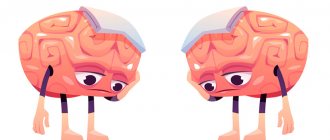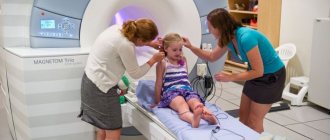Mental disorders
By 2021, diseases that are associated with mental disorders will appear in the top five diseases that lead to disability. This data is provided by the World Health Organization. According to recent studies, alarming symptoms worry every third resident of Russia.
Mental disorders occur for a number of reasons. These are external factors, heredity and genetic predisposition, although all the reasons are still not known to science.
Anything that disables the nervous system ultimately becomes the basis for the development of mental illnesses. Mental disorders occur for no apparent reason, and after stress, overwork, contact with toxic substances, consumption of alcohol and psychoactive substances.
Often, hereditary mental illnesses manifest themselves in childhood. Main symptoms:
- developmental delay
- excessive emotionality
- severe reactions to harsh remarks and adverse events
- inappropriate behavior
Other mental health problems become noticeable during adolescence. For example, signs of schizophrenia. Deviations that are associated with genetic predisposition also make themselves known early.
Mental illnesses are treatable. In our magazine, experienced psychiatrists and psychotherapists write about all the phenomena of psychiatry: about the clinical picture, diagnosis and methods that can return you to normal life. Who else to trust in such a serious matter if not competent and experienced doctors?
Doctors use clinical and laboratory methods to diagnose diseases. At the first stage, psychiatrists talk with the person and observe his behavior. There are laboratory and instrumental diagnostic methods - Neurotest and Neurophysiological test system.
Special medications can combat the disease. Experts prescribe antidepressants, tranquilizers, nootropics, and antipsychotics. Individual, group, family and gestalt therapy are also considered effective methods of rehabilitation.
Why do mental illnesses worsen in spring?
Psychiatric deviations are often insidious in nature; they can subside for a long time, and a person will feel healthy, but with the slightest change in external conditions, they will return and manifest themselves with renewed vigor.
This is why mental illnesses worsen in the spring: this occurs due to a sharp restructuring of natural factors that have a powerful effect on the human body: nervous activity, hormonal levels, blood supply and metabolism.
The prognosis for the recovery of people with mental disorders is very conditional; treatment is complex and complex, with the use of medications and psychotherapy.
As a result of treatment, some types of mental disorders are cured permanently, while others struggle with them for life.
Mental illnesses: list and description
Psychologists and psychiatrists identify the following groups and types of mental illnesses :
- Phobias (panic and stress states) are disorders that arise against the background of an exaggerated sense of fear. In these cases, the natural defensive reaction to danger becomes the dominant human response to any external stimuli.
- Depression . They manifest themselves as a loss of interest in life and a negative perception of it.
- Neuroses (hysteria, neurasthenia, obsessive states) occur with increased irritability and excitability of patients, imaginary somatic complaints, violent emotional reactions to life's difficulties and troubles.
- Mental retardation (in children) and mental retardation in all age groups. Such pathologies are characterized by a moderate or severe lag from normal indicators of thinking, perception, speech, behavioral or communication skills.
- Paranoid pathologies and schizophrenia are diseases that have specific symptoms. The hallmarks of paranoia include confusion and delusional thoughts. Schizophrenics try to isolate themselves from society; they are focused on themselves or some “super important” idea.
- Epilepsy is a disease that causes seizures and loss of consciousness.
- Affective pathologies . They manifest themselves as behavioral disturbances in response to ordinary external stimuli (reactions of anger, tearfulness, aggression).
- Psychoses . These conditions are associated with the development of mania (obsessive thoughts about persecution, sabotage, eavesdropping) or a combination of mania and a depressed state of mind (depressive thoughts about suicide, the presence of an incurable disease, the meaninglessness of existence).
Social anxiety
Social anxiety disorder (SAD) is a disorder in which severe anxiety and fear are associated with social situations and occur regularly. The person may experience discomfort when speaking in front of an audience, eating, meeting new people, or other activities in public places. According to modern data, up to 13% of the population have suffered or are suffering from SAD at some point in their lives. Most often (though not always), this disorder begins in childhood or adolescence and does not go away on its own.
SAD can be isolated (specific) - associated with a specific situation, or generalized, when anxiety appears in any social situations.
How to recognize social anxiety?
Social anxiety disorder is different from normal discomfort or embarrassment in awkward situations. SAD requires a certain duration (at least 6 months) and avoidance of situations that bring anxiety. Because of this, social, professional and other areas of a person’s life suffer. People with SAD tend to place high demands on themselves and others, expect “catastrophic” consequences in situations of social interaction, and overestimate the hostility of the environment.
What therapy is used? Both psychotherapy and medication treatment are used - SSRIs and SSRIs (selective serotonin and norepinephrine reuptake inhibitors). Cognitive behavioral therapy studies and reviews show moderate to high effect sizes. There is evidence of similar effectiveness between CBT and psychopharmacotherapy in the treatment of acute SAD, but in the long term, CBT is considered more effective.
How does it help? The cognitive part of the work in CBT is aimed at maladaptive thoughts and beliefs - a person learns to recognize negative thoughts about himself, change them, and gains skills to increase self-confidence in social situations. The behavioral component usually involves exposure therapy—experiencing situations that cause anxiety, embarrassment, and shame.
How long does it last? CBT for SAD can be carried out individually or in a group, with an average of 16–20 sessions once a week. Results last for 6–12 months, but there is evidence of sustained improvement up to 5 years after treatment.
Causes of mental disorders
The factors that cause mental illness are theoretical; the practical relationship with mental disorders has not yet been proven.
In medical science, there are 2 groups of possible causes that determine the appearance or progression of mental disorders:
- External : - exposure to toxins of biological (waste products of bacteria and viruses) or chemical (poisons and toxic substances) nature; — radioactive radiation; — traumatic brain injuries; - excesses in upbringing or lack of attention in childhood, emotional trauma (stress and anxiety) at any age; - abuse of psychoactive substances (alcohol and (or) drugs; - long-term physical illnesses; - professional activities that require constant concentration and concentration; - oxygen starvation of brain tissue.
- Internal : - genetic predisposition, heredity; - disturbance of the mechanisms of balance between the processes of tension and relaxation in the nervous system. - organic brain damage associated with acute or chronic inflammatory changes in it; - diseases of large and small vessels supplying blood to the brain structures.
The most common cause of mental disorders is organic damage to the brain or its blood vessels (strokes, tumors, injuries). At the same time, disturbances in the sphere of perception, thinking and speech can be temporary and disappear after treatment or accompany patients throughout their lives.
In cases of drug addiction and alcoholism , mental disorders progress steadily.
Preserving people's mental health is only possible if they completely abandon these addictions.
With the development of schizophrenic disorders, manifested in a sharp change in habitual life values and hobbies, paranoia with the development of delusional ideas, constant monitoring and treatment by a psychiatrist .
OCD
Obsessive-compulsive disorder is one of the most diverse and difficult to understand. It involves the presence of obsessive thoughts or ideas (obsessions) and/or rituals (compulsions) that a person feels necessary to perform in order to prevent an unpleasant outcome or relieve emotional stress. Obsessions are involuntary, almost always unpleasant, and the person often tries unsuccessfully to resist them.
Obsessive thoughts or actions occur to one degree or another in most people. It becomes a disorder if they cause significant anxiety or take a long time.
The most common obsessive thoughts:
- fear of infection by germs, disease, as well as fear of so-called mental pollution;
- contrasting obsessions - thoughts that contradict a person’s value system: about the possibility of harming oneself or others, obscene and blasphemous thoughts and images, fear of doing something unacceptable;
- regular desire to double-check electrical appliances, taps, doors;
- discomfort in the absence of symmetry and the desire to achieve it; and others.
What therapy is used?
The main psychotherapies for OCD are exposure and response prevention and cognitive behavioral therapy. They are not mutually exclusive and, in moderate to severe cases, can be combined with medication. These methods have confirmed their effectiveness in treating OCD in numerous studies - it is about 70-75%.
How does it help? Using CBT methods, the patient learns to refute the incorrect assessment of his obsessive thoughts, argue with himself, and identify thinking errors. To cope with protective behavior (rituals), behavioral experiments are used, ultimately demonstrating to the patient the groundlessness of his fears.
How long does it last? As a rule, 10-12 sessions are needed to notice an improvement in OCD symptoms. A significant reduction in symptoms occurs after 15-20 sessions.
Signs of a mental disorder
Each mental disease has its own clinical picture.
You can suspect the presence of such disorders by observing the following symptoms and signs:
- a person persistently gives out wishful thinking;
- expresses incoherent (delusional) thoughts;
- strives for loneliness and isolation, tries to isolate himself from any communication with others;
- reacts sharply to troubles and criticism (throws hysterics, shows verbal and physical aggression);
- cannot concentrate attention on important things, conversation, household or professional activities for a long time;
- lives in the past and constantly remembers difficult life experiences, is immersed in a world of illusions, with a reduced reaction to objective circumstances and external stimuli;
- memory deteriorates, gaps appear in it;
- the patient constantly performs some obsessive actions and rituals (frequently washes his hands, arranges household items only in a certain order, leaves the house only under a combination of circumstances that suit him).
Reactions to stress: PTSD
Stress is a universal physiological reaction to the influence of various unfavorable factors, physical or psychological. The goal of therapy in this case is to help the person adapt to changes.
Reactions to stress can be different, and they do not always require the intervention of specialists. Some of them go away on their own after a certain time. But some, such as post-traumatic stress disorder (PTSD) and complicated grief, can last for years and significantly impair a person's quality of life. In such cases, it is necessary to contact a psychotherapist or psychologist.
Traumatic events are situations that pose a direct or indirect threat to the life and health of the person himself or his loved ones (including sexual violence). In cases of prolonged or extreme traumatic events, such as torture, child sexual abuse, severe domestic violence, etc., complex PTSD may develop.
PTSD may be partial (subclinical), meaning it may not meet all the criteria for a diagnosis. But if there is a decrease in quality of life due to presenting symptoms, then intervention is also required.
How to recognize PTSD?
Signs of the disorder: worries about the traumatic event in involuntary thoughts and memories, nightmares, flashbacks; avoidance of thoughts, actions and situations associated with the traumatic event; increased alertness and overexcitation, insomnia.
What therapy is used? Recommended therapy for PTSD, according to American Psychological Association and NICE practice guidelines:
- Trauma-Focused Cognitive Behavioral Therapy (TF-CBT): Prolonged Exposure Therapy; cognitive therapy; cognitive processing therapy.
- Eye movement desensitization and reprocessing.
- Short-term integrative therapy.
- Narrative exposure therapy.
How does it help? As a result of therapy, a person learns to process his trauma: the event will remain in the past and will no longer affect the quality of life. To understand this process, you can imagine that we have a large closet full of crumpled things, where everything is mixed up. The only way to get organized is to open the closet and go through all the things; the same thing happens with traumatic experiences in the process of work. There is evidence that the average patient treated with prolonged exposure therapy does better than 86% of the control group; Other “focused” methods give similar results.
How long does it last? On average, all interventions take from 8 to 16 sessions (session duration is from 45 to 90 minutes), but sometimes more may be required.
Diagnostics
Only a specialist can establish a mental disorder; for this, he comprehensively studies the patients’ complaints and lifestyle, and conducts an examination using clinical methods.
The use of special questionnaires allows us to identify anxiety disorders, predisposition to depression, affective disorders, and aggression.
Many psychological techniques used in psychiatry have been adapted for use by ordinary people and are posted on the Internet.
Nowadays, anyone can take a mental illness test online and get an interpretation. The network contains the characterological questionnaire of K. Leonhard, the Sheehan anxiety scale, and the Rorschach blot technique.
However, when conducting such tests, people must understand that the information from them is of an introductory and tentative nature; only a doctor can give an accurate interpretation of the test studies.
In addition, instrumental methods may be required to diagnose the causes of mental disorders:
- electroencephalogram;
- X-ray or MRI of the head;
- substance use tests;
- blood chemistry.
BAR
Bipolar affective disorder (BID) is a disorder in which manic (emotional, energetic, cheerful, but often irritable) and depressive episodes alternate. BAR has two forms. Type I includes one or more episodes of mania or major depression. In type II bipolar disorder, there are short episodes of hypomania (a milder form of mania), but depressive phases predominate. There is also cyclothymia - multiple cyclical mood swings in the form of hypomania and mild depression for at least two years of life.
What therapy is used? Medicines are the main, but not the only effective treatment for bipolar disorder: in the case of taking medications alone (these are mood stabilizers, antidepressants, and sometimes antipsychotics and tranquilizers), the relapse rate in the next two years is approximately 60%.
Some patients with bipolar disorder may have problems with adherence to medications and/or the effects of the disorder. This is where psychotherapy can make a difference. According to the American Psychological Association, the psychotherapy of choice for the treatment of bipolar disorder may include psychoeducation, CBT, interpersonal and social rhythm therapy, and family-focused therapy.
How does it help? Psychotherapy allows us to understand the mechanisms of the disease and the consequences of its impact on social life. Mood is stabilized, hospitalizations are reduced, and the patient gains cognitive and behavioral skills to manage symptoms. Thanks to this, the quality of life and relationships with other people improve.
How long does it last? A difficult question: bipolar disorder often occurs in parallel with other disorders, such as addictions, and this affects the duration of therapy. Most likely, with bipolar disorder, psychotherapy will be supportive in nature, that is, it will be long-term. Psychoeducation and normalization can take 10–15 sessions.
Symptoms of mental disorder in men
In the male population, the most common mental disorders are:
- schizophrenia;
- persecution mania;
- sexual disorders (decreased potency, premature ejaculation, desire for perversion).
Mental disorders in men are characterized by:
- deterioration of general well-being and decreased emotional background;
- the occurrence of unreasonable reactions of anger, aggression and irritability;
- desire to limit contacts with people, avoidance of female society, immersion in professional activities.
Mental disorders are more common in men than in women.
This is due to the spread of harmful addictions among them (alcoholism and drug addiction), hormonal characteristics (increased levels of testosterone and norepinephrine), work related to dangerous and responsible professions (managing land, air or sea modes of transport, being in political, police and army posts).
Depression
According to statistics, the prevalence of depression
continues to grow (up to 20% of the population) and in the coming years may overtake cardiovascular morbidity. Mild forms of depression are especially common, occurring latently, with not obvious symptoms.
Depression is not an invention of psychiatrists, but a serious illness!
Depression is most widespread among urban residents, resulting from information overload, sleep-wake rhythm disturbances, abuse of stimulants, etc.
Symptoms in women
Women most often suffer from pathologies in the affective sphere, depression, eating disorders (bulimia, anorexia) and nighttime sleep disorders (insomnia), increased anxiety and persistent phobias.
Signs of mental disorder in women:
- loss of interest in one’s appearance (lack of care), family, children, work, the opposite sex;
- tearfulness, irritability, suspiciousness;
- neglect of food or constant overeating, fear of nightfall, fear of leaving the house, etc.;
- memory loss, absent-mindedness, self-absorption;
- various complaints about physical health (headaches, gastrointestinal disorders, heart failure).
Mental illnesses in children
The most common mental illnesses in children are developmental delay (developmental delay), autism and hyperactivity.
1. Delayed development of a child can manifest itself in a small vocabulary for his age, the inability to master certain actions and games that peers operate in full.
2. Autism (a childhood form of schizophrenic disorder) is characterized by the child’s voluntary withdrawal from communication with adults and children, isolation, hypertrophied development of any one ability of the child (counting, drawing, singing) or a progressive decline in intelligence.
3. Hyperactivity in children consists of the inability to concentrate attention, maintain motor calm, perceive learning in full and control their behavior.
Treatment of disorders
Therapy for mental disorders involves a number of activities:
- psychotherapy (individual and group classes), auto-training, neurolinguistic programming;
- course of medication, depending on the cause of the disease: sedatives (Valerian, Motherwort, Afobazole, Tenoten), tranquilizers (Hydroxyzine, Buspirone and analogues); neuroleptics (Propazina, Flupenthixol), antidepressants (Befola), nootropics (Mexidol, Pantogama), mood stabilizers (Valpromide, lithium salts);
- acupuncture, massage, narzan baths;
- giving up bad habits, avoiding stress, leading a healthy lifestyle.









